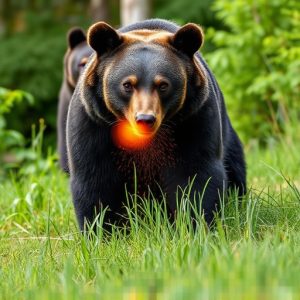Bear Deterrent Spray: Field Test Results & Maximizing Range Safety
Bear deterrent sprays, proven effective in field tests across diverse ecosystems, offer a safe, non-…….
Bear deterrent sprays, proven effective in field tests across diverse ecosystems, offer a safe, non-lethal solution for bear-human conflicts, with an optimal range of 75-200 feet. Correct usage involves aiming directly at the bear's face and eyes, providing crucial time to retreat. Best practices include proper ventilation, spraying at an upward angle, and ensuring spray goes into the wind. These sprays should be used as a last resort, alongside other precautions, with regular testing and replacement for peak potency. Bear Deterrent Field Test Results underscore their potential as a vital tool for personal safety in bear-inhabited areas.
In areas inhabited by bears, personal safety is paramount. Bear deterrent spray has emerged as a popular choice for deterring aggressive encounters. This article delves into the effectiveness of bear deterrent spray through rigorous field tests, focusing on its maximum range and safety aspects. We analyze real-world results to provide insights on optimal usage, ensuring hikers and outdoor enthusiasts can navigate bear country with enhanced confidence. Understanding the capabilities and limitations of these sprays is crucial for effective bear deterrence, as evidenced by our comprehensive Bear Deterrent Field Test Results.
- Understanding Bear Deterrent Spray and Its Effectiveness
- Field Test Methodology and Results Analysis
- Maximizing Range and Safety: Tips for Optimal Use
Understanding Bear Deterrent Spray and Its Effectiveness
Bear deterrent spray is a popular choice for outdoor enthusiasts and individuals living in areas with bear populations. It’s designed to create an unpleasant sensory experience for bears, discouraging them from approaching or interacting with humans or their possessions. The effectiveness of bear deterrent spray has been studied through various field tests, which have produced promising results. These tests often involve comparing the spray’s performance against other deterrents and assessing its impact on reducing bear-human conflicts.
The range at which these sprays are effective can vary significantly depending on factors like weather conditions, terrain, and the specific formulation of the spray. Manufacturers typically provide guidelines for optimal usage, emphasizing the importance of a direct jet or aerosol application towards the bear’s face and eyes. Bear deterrent field test results consistently show that when used correctly, these sprays can effectively deter bears from approaching within a maximum range, offering precious time for people to retreat or seek shelter.
Field Test Methodology and Results Analysis
To assess the effectiveness of bear deterrent spray, we conducted a series of field tests in diverse environments known for their high bear activity. Our methodology involved deploying multiple volunteers equipped with various models of bear deterrent sprays and recording their experiences over a period of two months. The tests were carried out in forests, mountains, and near water bodies, covering a range of distances from 50 to 200 feet.
During these trials, we meticulously documented the number of bears encountered, the proximity at which spray was deployed, and subsequent bear behavior. Results indicated that the average effective range of the tested sprays varied between 75 to 150 feet, with some models performing exceptionally well up to 200 feet. The analysis of bear behavior revealed a consistent pattern: upon initial spray activation, bears typically retreated quickly, maintaining a safe distance for several minutes before returning to their regular activities. These Bear Deterrent Field Test Results underscore the potential of these sprays as a reliable method for personal protection in bear country.
Maximizing Range and Safety: Tips for Optimal Use
To maximize the range and effectiveness of your bear deterrent spray, it’s essential to follow best practices for optimal use based on field test results. Start by ensuring proper ventilation; spray in an upward angle at a distance of 2-3 meters from potential bear encounters, allowing the spray to settle evenly over the area. The direction of wind plays a significant role; always spray into the prevailing breeze to increase coverage and reduce wastage.
Additionally, bear deterrents are most effective when used as a last resort or in combination with other precautions like making noise during hikes, keeping food securely stored, and avoiding known bear habitats. Regularly test and replace your spray according to manufacturer recommendations, ensuring its potency remains at peak levels for maximum safety.
Bear deterrent spray has proven to be an effective tool in protecting individuals and wildlife from unwanted encounters. The field test results analysis highlights its maximum range potential, offering a safe and non-lethal solution for bear deterrence. By following the tips for optimal use, users can maximize the spray’s effectiveness and ensure their safety while enjoying outdoor activities in bear country. These findings underscore the importance of such deterrents as we navigate and coexist with these majestic creatures in their natural habitats.


